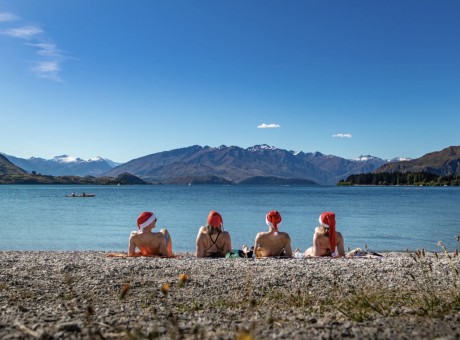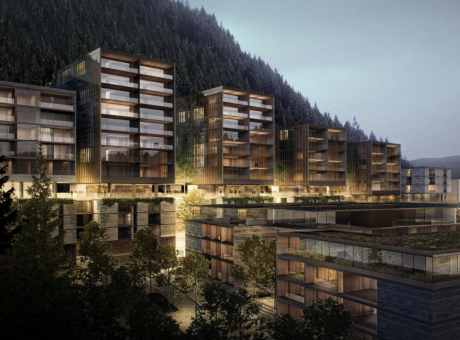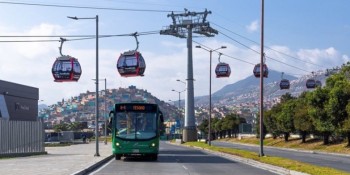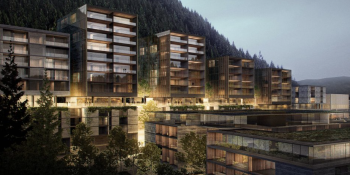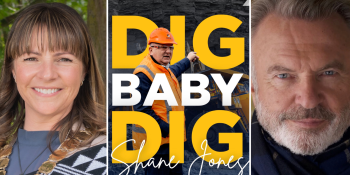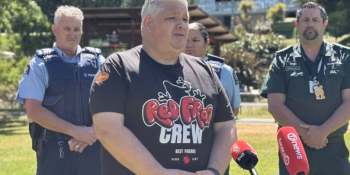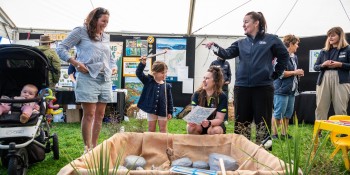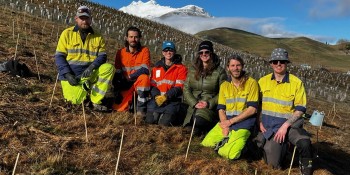Cracking the better houses challenge - and reducing waste
There’s no hiding it in a growing town - building homes creates huge amounts of waste. So how can we build better? Turns out, there’s an app for it. For part of the problem, anyway. CivilShare lets tradies (and DIYers) share tools, materials, staff and info, with the aim of keeping anything from being wasted.
It’s the brainchild of Auckland’s Regan Burke, who spoke last night at the Building Better workshop in Queenstown. “We just got frustrated with having to send guys home in between projects, or having equipment sitting around not doing anything, and so much material going to landfill.”
A builder himself, Burke spells out the reality that kicked him into action. “Forty to sixty per cent of waste that goes to landfill is construction and demolition waste. Which is a pretty big issue.”
In New Zealand, he says, our waste levy is almost embarrassing - $10 per tonne, compared to the UK, Australia and Canada where it’s upwards from $180.
There’s no reason this waste can’t be diverted, though, and used to build other things. The app has taken off in Auckland over the last couple of years, and in 2018 Westlake Boys High School used it to build a sports office entirely out of demolition waste.
Burke is keen to see the Southern Lakes community get the same use from the free app, which he funds with the help of Auckland Council’s Waste Minimisation Innovation Fund.
His was just one voice at last night’s discussion, which was part of the ONE summit. It brought experts together to discuss how everyone involved in the building sector, including the community, can help improve outcomes.
It’s a conversation that, in this region, needs to be had, and starting it has clearly been a popular move with those in the industry. According to Sophie Mander, QLDC’s Waste Minimisation Officer, a ‘big kiwi bloke in high-vis’ came running over to give her a hug in the street after her presentation at the Wanaka workshop on Wednesday night..
While Queenstown saw a smaller audience, both workshops ran over-time with questions - people didn’t want to leave.
The carbon footprint of new homes was a well-explored topic. Dennis Dowling is known for producing efficient homes in the area with his company Dowling Construction and Development, and spoke to the group about how much influence a builder can really have.

Dennis Dowling thinks a whole-system approach is needed to design waste out of the building process
Dowling said, from a builder’s perspective, if the aim is to reduce your carbon footprint, focussing on long-term building performance rather than the waste on-site that will have the biggest effect.
“There can be a lot of focus on waste minimisation at the time of construction, but the builder’s ability to influence that onsite is actually fairly limited. Their ability to influence the way the building performs is so much greater.”
This building performance, efficiency, or carbon footprint is something more and more people are looking for when they come to Dowling. But they also come with a budget.
It’s a common assumption that affordability and carbon friendliness are mutually exclusive. Dowling says absolutely not, but you have to be willing to make compromises.
“It’s about what you prioritize. Don’t lead with size. You may not have as big a house, or you might have to give up that stone benchtop for better windows, for example.”
It’s these kinds of changes that give a greater yield in the long run, Dowling says, and where builders can have the most impact. When it comes to on-site waste, a lot of it is predetermined by design.
He puts it pretty simply. “The design sets up the materials that you’re going to use. If a wall is designed at 2 metres long and your sheets come in 3 metre lengths, you’re always going to have a 1 metre off-cut. Something’s going to go to waste.”
Dowling says what builders can do is limited to separating waste, for which in New Zealand, there are no facilities. “The collection and processing is time consuming and somebody’s got to pay for that. For a builder to do that out of good will is just not realistic. In the US as a builder, I’d have a concrete bin, waste bin and a timber bin and they would all get diverted at no cost.”
Of course, that’s without the CivilShare app sharing that excess around the community. But Dowling thinks a lot of this waste could be designed out further up the chain. He says the use of prefabrication, where homes are pre-manufactured off-site, is fantastic.
“The reason it doesn’t generate as much waste is that the guys prefabricating are often the design team. So the design, the production, the production of waste and the increase of profit are all in the same bucket.”
Dowling argues that the current model of building makes it hard to lower a home’s carbon footprint; typically the design is completely isolated from the waste production. He says a systemic approach where the builders can influence the design would allow them to build better for less money.
Wanaka-based passive house designer, Jessica Eyers, says she’s with Dowling on the prefab point.
“It’s a good answer because they’ve got more incentive to minimise waste - I think that’s where New Zealand construction is going.”
Eyers, who runs architectural design and construction company Hiberna, says that in practice, it can be difficult to design out waste by designing to manufactured sizes. There are definitely design measures that they can (and do) take, though, such as minimising the use of jib board which requires off-cuts.

Passive House Designer Jessica Eyers says more people are opting to go small
Eyers is part of the design team working on the new Luggate town hall, the first passive community building in New Zealand. A passive building, by the way, is one that maintains a comfortable temperature and air quality with minimal or no energy input.
While she says passive homes are more expensive to build, she’s finding more and more people choosing to go small so they don’t have to compromise on this long term efficiency.
At the moment there’s only one guy who can qualify passive homes in New Zealand, and he was also there last night. According to Jason Quinn, our buildings suck because we try to look at one factor in isolation. He, like Dowling, was advocating a whole systems approach.
This, essentially, was the aim of the workshop itself - to link together the various players in Queenstown’s building sector to tackle the issues from all angles.
It’s something Wanaka did last year, with their Building Better working group still meeting monthly to discuss design, materials, waste and mental health.
It’s a complex issue, and certainly not one that can be solved in one evening (or article). But by the time the workshop dispersed, pieces from all corners were starting to come together, and plans were made to keep the conversation going.
Main Image: Regan Burke runs the CivilShare app to help reduce construction waste
The One Summit continues this weekend, with Future of Farming this evening, full day carbon zero sessions on Saturday, and the Wanaka Eco Fair on Sunday. Check out the programme and get your tickets here
If you’re interested in learning more about passive homes, the Earth Building conference is on this weekend in Cromwell.





